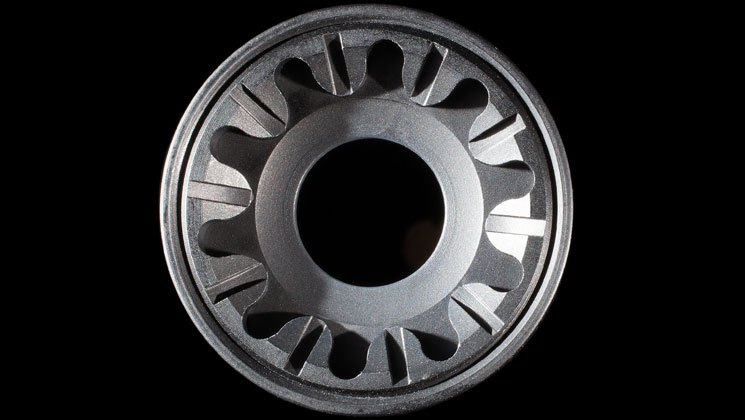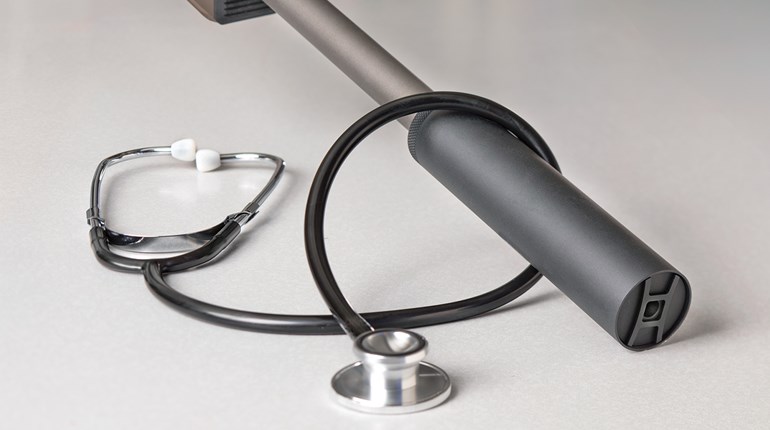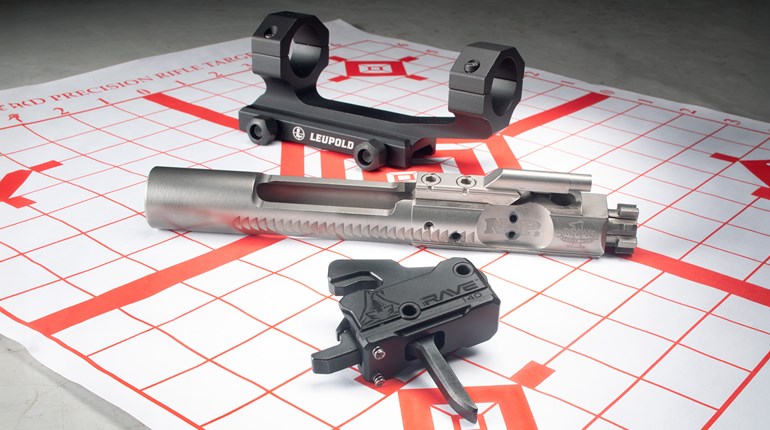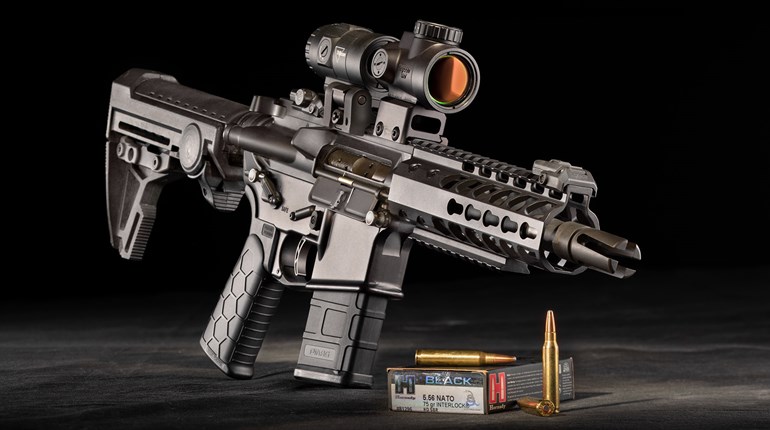

Quiet guns make for happy shooters and happier neighbors. Regardless of firearm type, reducing sound at the muzzle is good for everyone’s ears, and also tends to reduce complaints about “noise pollution.” Sound suppressors (also known as silencers, suppressors or cans) provide a way for the average shooter to reduce noise, whether shooting in the backyard or at a range. Muzzle flash is also greatly reduced, since most of the hot gasses that follow a projectile out of a rifle or handgun barrel are siphoned off into the suppressor, where they cool before they can ignite in the open atmosphere. Most suppressors give a slight bump in velocity, which is usually good, unless you are attempting to shoot subsonic ammo loaded very close to the speed of sound for your environment. The extra weight a suppressor adds to the firearm aids in muzzle control, allowing for faster follow-up shots and, in some cases, better accuracy. None of this is new information, though— suppressors have been around for more than 100 years.
Backstory
The late 19th century witnessed such firearm innovations as smokeless powder, centerfire ammunition, machine guns and, as one patent claimed, “Silent Firearms.” While some such advancements reached maturity quickly enough to be used during World War I, suppressors were much slower to bear functional fruit. Patents filed between 1899 and 1910 show various attempts to quiet firearm noises using devices that ranged from wacky to ingenious. During that time, Hiram P. Maxim (whose father invented the Maxim machine gun) came up with a design that trapped escaping gasses at the muzzle, rerouting and spinning them into tiny, conch-like chambers to allow a slower dissipation of gas. Maxim was not the first to come up with a baffle approach to suppressor design, but period writings suggest his 1902 “Maxim Silencer” worked well enough. Unfortunately, it did not set sales records. The Maxim design was expensive to manufacture and prone to excessive heating due to all the friction created by those swirling gases. Attempts to develop functional suppressors continued sporadically throughout the 20th century, but those seeds of silence would not fully blossom until the Second World War, when clandestine operatives capitalized on the benefits of sound-suppressed handguns in dangerous, far-away places. I will wager passage of the National Firearms Act of 1934—which hampered silencer ownership with the same additional taxes and federal registration process required for machine guns, short-barreled rifles and short-barreled shotguns—took a big bite out of suppressors’ early commercial viability. Imagine how much harder it was to pay the $200 transfer tax at the height of the Great Depression than it is today.
Despite those early struggles and continued heavy regulation, commercial sound-suppressor efforts have blossomed in recent years. Handgun cans have been the slowest to gain mainstream commercial acceptance, but that is changing rapidly. Better education of the shooting public on the legal transfer process coupled with the arrival of a plethora of functional and affordable products onto the market have moved pistol suppressors out of museums and fiction novels and into the hands of modern citizens. Recreational shooters and home defenders are finally benefitting from the same advantages suppressors have provided to our military and law enforcement personnel for decades.

Form & Function
Like their rifle-mounted cousins, handgun suppressors come in three basic varieties: integral, quick-detach (QD) and thread-on. Integral suppressors surround a portion of the barrel and rely on ports drilled along the barrel’s length to siphon gas off. They are usually permanently attached to the handgun and are most commonly seen on .22 LR pistols. Unlike the rifle market, threaded handgun cans are more common than QD designs, likely because of efforts to standardize mounting systems while keeping costs and weights as low as possible.
Attempts were made at least as far back as the early 20th century to suppress revolvers, but very few designs have succeeded. Gasses escaping at the muzzle and from the cylinder/barrel junction must each be dealt with. The Russian Nagant 1895 “gas seal” revolver addresses the latter problem by using special cartridges and a unique operating mechanism. As the Nagant’s hammer moves rearward, the cylinder moves forward until its face rests on the opposing breech face. Projectiles for the 7.62 Nagant round are seated deeply into extended shell casings, so the brass case mouths seal the gap as each chamber rotates into alignment with the bore.

The gas-seal concept has been used by specialty manufacturers on a small number of modern, suppressed revolvers for use by clandestine forces. I had quite a bit of experience with a couple of these designs while in the Army. They were chambered for sub-caliber projectiles and loaded to subsonic velocities in special casings. What they lacked in “firepower” they more than made up for in effective sound reduction. It was not uncommon for someone nearby to be clueless that several shots had been taken. Other than the metallic noise made by the hammer hitting a transfer bar and a slight pfffft of gas behind the slow-moving bullets, no obvious audible signature was evident. But such specialty handguns are expensive to feed and there is not much of a market for them—casual searching did not turn up any commercially available revolver suppressors, but it appears a few custom builders exist.
Suppressors for semi-automatics are more common for handguns, but they have their own unique challenges designers must overcome. The first is semi-auto actions necessarily open during the cycle of firing, allowing some gas and mechanical noise to foil the suppressor’s best sound-reduction efforts. Very few handgun manufacturers deal with this concern, since commercial suppressor users do not typically require near-silence. If the mission called for it, I usually carried a locking slide, suppressed Beretta 92 variant while in uniform. Compared to other options, I figured I had at least a fighting chance with 9 mm should things not go as planned. The Beretta’s lockable slide was actuated by an ambidextrous lever lock that physically stopped it from reciprocating. It could be fired as a semi-automatic or hand-cycled, and was very quiet with subsonic ammunition.

A major negative, however, was its suppressor used replaceable “wipes” that wore out quickly. These small, dense, plastic-like wafers are stacked inside a suppressor’s body and are either pre-drilled or perforated by the first bullet. I always pre-shot mine, because that first round would invariably be several feet off target at 25 meters. Typically, I could get about 10 rounds through the Beretta’s QD can before the wipes were shot out. Perhaps this is why the wipe system is not very common today, and has largely been replaced by sound suppressors with alloy or stainless steel baffle stacks.
The second problem with suppressing semi-autos relates to reliable functioning. Very few pistols were designed with suppressors in mind, so hanging weight on the end of their barrels tends to inhibit the way they operate. The problem is greatest with barrels that move and tilt to unlock from the slide during cycling. Most modern pistol suppressors use some form of recoil-booster system—commonly a Nielsen device—to help operate the slide. These devices “decouple,” or momentarily remove that weight from the pistol’s barrel, at the critical moment, while boosting the slide rearward to improve function. Many pistol suppressors can be rotated into different positions by way of the Nielsen device’s spring and indexed internal-piston notches. Each position changes the point of impact on target, which ideally brings suppressed and unsuppressed zeroes closer together.

The metal baffles used in suppressors to channel gasses and reduce pressure vary in design and materials used. Some cans allow their baffle stacks to be removed for maintenance or repair, while others are simply cleaned by immersion in solvent. Handgun suppressor prices vary, but price is not always an indicator of performance. The most expensive model sampled for this review had the poorest accuracy and largest zero shift. I encountered similar problems during my R&D time in the Army. If we tested 10 identical semi-automatic handgun suppressors on 10 identical handguns, the only thing we could count on was no two would do the same thing. Even with modern updates to the old designs and better materials, the surest way to know how a suppressor will get along with a particular handgun is to introduce them to each other on the range. Despite these variances, every handgun-mounted suppressor I have used in the last two decades has been capable of “minute of bad guy” accuracy at reasonable self-defense ranges.
Setting Up
Unless your handgun came with a suppressor-ready barrel, you will need one that is either threaded or has a QD capability matching the desired suppressor. Drop-in options for semi-autos are available from several sources, but as with most other handgun parts, they do not always drop-in. I ordered a stainless steel 4-inch barrel for my very seasoned Springfield XD45 from Storm Lake to evaluate the suppressors for this test. The new barrel needed minor fitting to gain clearance on the breechface, which was done quickly by the nimble hands of gunsmith Mike Allen at MHA Custom. You will need to know the thread/pitch and direction of threading a suppressor requires so you can order the correct barrel. That information should either be marked on the suppressor or in the manual, and is always available from the can's manufacturer.

Most threaded barrels come with thread protectors on the end. These are great at preventing damage to the threads, but generally terrible at staying tight while firing unsuppressed. I have tried hand tightening, wrench tightening (which mars the surface) and reusable thread-binding compounds. None of these options seems to work for very long. Take care not to damage the threads if you choose to leave them unprotected, as I do.
Factory handgun sights are almost always too short to see over the top of a can. It is possible to use stock sights in a pinch, but you end up having to hold low on the target in order to see it above the top of the suppressor. If you are going through the nearly year-long process and expense of transferring a suppressor to your personal inventory, get a set of tall sights to go with it. Glock shooters will be thrilled to know there seem to be a few million options for tall Glock sights, but the rest of us have to look around a bit. I decided to revisit my past by ordering a set of adjustable sights from Dawson Precision. One of my Army-issued 1911s wore Dawson sights, and I loved them. Click adjustments are positive and the rear sights have low enough profiles to stay out of the way. I chose a fiber-optic front that is .285 inch high. The folks at Dawson said a .285-inch-high sight would work fine for most suppressors, and they were right. The top of the sight lined up evenly with the largest-diameter can I tested, but was not so tall as to be excessive when shooting without a can.
Options for carrying a handgun with a mounted suppressor are limited; wearing a handgun with the suppressor mounted is about as fun as playing catch with a cactus. Still, there are jobs and situations where holstering a suppressed pistol may be required, so a few options do exist. Unless you have a suppressor slim enough to fit through an open-bottom holster, you will have to choose between one of the few nylon pouch-type holsters or carrying with the suppressor detached. Many moons ago I made a chest rig out of ballistic nylon, thin plastic sheeting and hook-pile tape that could be worn either as a shoulder holster in the field or attached to my assault vest. It has about $10 worth of material in it and looks like it was lifted off a bum, yet it survives intact today after a long history of use in harsh environments. Crye Precision offers its innovative GunClip, which is more of a bracket than a holster, that allows a mounted suppressor to be carried.
Older suppressors with wipes and some integral designs scrub velocity, so it pays to check your setup just to be sure. This is particularly important if you are using hollow-point bullets that rely on velocity to expand. Also, remember supersonic ammo is going to make the same loud noise it always does while moving through the air, even when fired through a suppressor. Subsonic ammunition is the ticket for quiet operation, but is not widely available for all common handgun calibers.

Snapshots
I performed a simple comparison test of four currently available handgun suppressors using my XD45. Other than the threaded barrel and adjustable sights, it is a stock pistol. I get 2-inch groups at 25 yards using good match or defensive ammo with this handgun. My unsuppressed velocity was 839 fps at 85 degrees Fahrenheit. All shooting was done from a rest at 25 yards using an Oehler 35P chronograph placed at 15 feet in front of the muzzle to measure velocities. Accuracy was assessed by averaging the extreme spread of five, five-round groups through each suppressor using the same Winchester 230-grain FMJ match ammunition. All suppressors were checked for tightness after each group and all remained tight throughout testing. A total of 50 rounds were fired through each model. No hearing protection was used when firing suppressed. The sounds levels generated by each system were different, but none were harsh on my ears.
The coming years will see more innovative and less-expensive suppressors designs in the commercial market. While not completely silent or without quirks, they add to a sidearm’s utility, and are a heck of a lot of fun to shoot.







































